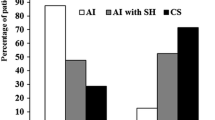Abstract
We have studied the variation of ACTH, cortisol and DHEA-S plasma levels in 6 patients before and up to 15 months after surgical remission of Cushing’s syndrome in order to compare the relative dependency of cortisol and adrenal androgens towards ACTH. Three patients with adrenal adenoma were treated by unilateral adrenalectomy. Three other patients with Cushing’s disease underwent transsphenoidal pituitary tumorectomy. Preoperative ACTH was undetectable in patients with adrenal adenoma and high-normal or elevated in patients with Cushing’s disease. All patients became rapidly hypocortisolemic after surgery and ACTH and cortisol levels eventually recovered at different intervals. Patients with adrenal adenoma had an initially low DHEA-S which failed to normalize for the entire follow-up period. Patients with Cushing’s disease had normal or high-normal DHEA-S which became low immediately after surgery, following ACTH decrease, and it remained low during the entire follow-up period. In conclusion, after removal of corticotropic inhibition secondary to excess cortisol, DHEA-S remains suppressed for a longer period of time than cortisol. Moreover it only takes a short period of relatively low ACTH (after pituitary tumor excision) to induce a long lasting DHEA-S inhibition. Therefore the DHEA-S secreting adrenal cells seem to be more sensitive to the lack of corticotropic stimulation than cortisol secreting cells.
Similar content being viewed by others
References
Avgerinos P.C., Cutler G.B., Jr, Tsokos G.C., Gold P.W., Feuillan P., Gallucci W.T., Pillemer S.R., Loriaux D.L., Chrousos G.P. Dissociation between cortisol and adrenal androgen secretion in patients receiving alternate day prednisone therapy. J. Clin. Endocrinol. Metab. 65: 24, 1987.
Parker L.N., Odell W.D. Evidence for existence of cortical androgen-stimulating hormone. Am. J. Physiol. 236: E616, 1979.
Anderson D.C. The adrenal androgen-stimulating hormone does not exist. Lancet 2: 454, 1980.
Parker L., Lifrak E., Shively J., Lee T., Kaplan B., Walker P., Calaycay J., Florsheim W., Soon-Shiong P. Human adrenal gland cortical androgen-stimulation hormone (CASH) is identical with a portion of the joining peptide of pituitary pro-opiomelanocortin (POMC). 71st Annual Meeting of the Endocrine Society, Seattle, June 21–24, 1989, Abstract 299.
Yamaji T., Ishibashi M., Sekihara H., Itabashi A., Yanaihara T. Serum dehydroepiandrosterone sulfate in Cushing’s syndrome. J. Clin. Endocrinol. Metab. 59: 1164, 1984.
Cutler G.B. Jr., Davis S.E., Johnsonbaugh R.E., Loriaux D.L. Dissociation of cortisol and adrenal androgen secretion in patients with secondary adrenal insufficiency. J. Clin. Endocrinol. Metab. 49: 604, 1979.
Author information
Authors and Affiliations
Rights and permissions
About this article
Cite this article
Kleiber, H., Rey, F., Temler, E. et al. Dissociated recovery of cortisol and dehydroepiandrosterone sulphate after treatment for Cushing’s syndrome. J Endocrinol Invest 14, 489–492 (1991). https://doi.org/10.1007/BF03346848
Received:
Accepted:
Published:
Issue Date:
DOI: https://doi.org/10.1007/BF03346848




